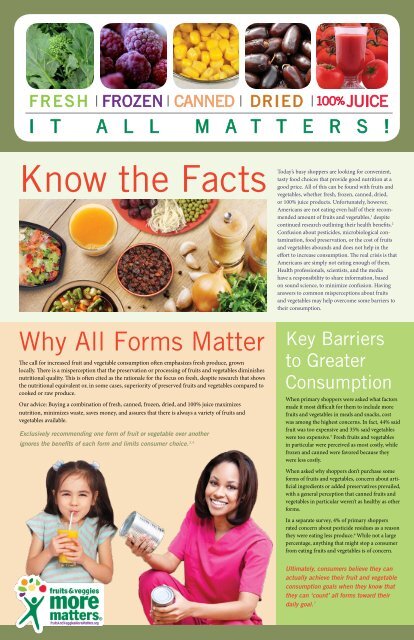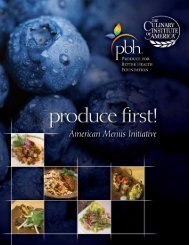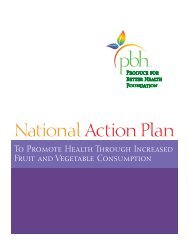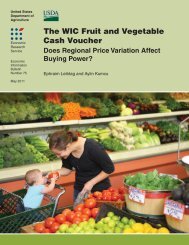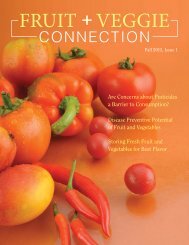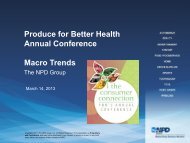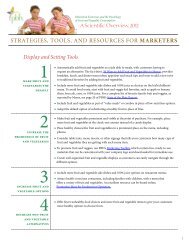Why All Forms Matter Brochure - Produce for Better Health Foundation
Why All Forms Matter Brochure - Produce for Better Health Foundation
Why All Forms Matter Brochure - Produce for Better Health Foundation
You also want an ePaper? Increase the reach of your titles
YUMPU automatically turns print PDFs into web optimized ePapers that Google loves.
Know the Facts<br />
Today’s busy shoppers are looking <strong>for</strong> convenient,<br />
tasty food choices that provide good nutrition at a<br />
good price. <strong>All</strong> of this can be found with fruits and<br />
vegetables, whether fresh, frozen, canned, dried,<br />
or 100% juice products. Un<strong>for</strong>tunately, however,<br />
Americans are not eating even half of their recommended<br />
amount of fruits and vegetables, 1 despite<br />
continued research outlining their health benefits. 2<br />
Confusion about pesticides, microbiological contamination,<br />
food preservation, or the cost of fruits<br />
and vegetables abounds and does not help in the<br />
ef<strong>for</strong>t to increase consumption. The real crisis is that<br />
Americans are simply not eating enough of them.<br />
<strong>Health</strong> professionals, scientists, and the media<br />
have a responsibility to share in<strong>for</strong>mation, based<br />
on sound science, to minimize confusion. Having<br />
answers to common misperceptions about fruits<br />
and vegetables may help overcome some barriers to<br />
their consumption.<br />
<strong>Why</strong> <strong>All</strong> <strong>Forms</strong> <strong>Matter</strong><br />
The call <strong>for</strong> increased fruit and vegetable consumption often emphasizes fresh produce, grown<br />
locally. There is a misperception that the preservation or processing of fruits and vegetables diminishes<br />
nutritional quality. This is often cited as the rationale <strong>for</strong> the focus on fresh, despite research that shows<br />
the nutritional equivalent or, in some cases, superiority of preserved fruits and vegetables compared to<br />
cooked or raw produce.<br />
Our advice: Buying a combination of fresh, canned, frozen, dried, and 100% juice maximizes<br />
nutrition, minimizes waste, saves money, and assures that there is always a variety of fruits and<br />
vegetables available.<br />
Exclusively recommending one <strong>for</strong>m of fruit or vegetable over another<br />
ignores the benefits of each <strong>for</strong>m and limits consumer choice. 3,4<br />
Key Barriers<br />
to Greater<br />
Consumption<br />
When primary shoppers were asked what factors<br />
made it most difficult <strong>for</strong> them to include more<br />
fruits and vegetables in meals and snacks, cost<br />
was among the highest concerns. In fact, 44% said<br />
fruit was too expensive and 35% said vegetables<br />
were too expensive. 5 Fresh fruits and vegetables<br />
in particular were perceived as most costly, while<br />
frozen and canned were favored because they<br />
were less costly.<br />
When asked why shoppers don’t purchase some<br />
<strong>for</strong>ms of fruits and vegetables, concern about artificial<br />
ingredients or added preservatives prevailed,<br />
with a general perception that canned fruits and<br />
vegetables in particular weren’t as healthy as other<br />
<strong>for</strong>ms.<br />
In a separate survey, 4% of primary shoppers<br />
rated concern about pesticide residues as a reason<br />
they were eating less produce. 6 While not a large<br />
percentage, anything that might stop a consumer<br />
from eating fruits and vegetables is of concern.<br />
Ultimately, consumers believe they can<br />
actually achieve their fruit and vegetable<br />
consumption goals when they know that<br />
they can ‘count’ all <strong>for</strong>ms toward their<br />
daily goal. 7
<strong>All</strong> <strong>for</strong>ms of fruits and vegetables provide needed nutrients<br />
From a nutrition and sensory standpoint,<br />
recipes prepared with canned and/or frozen<br />
ingredients have been rated as comparable to<br />
those prepared with cooked fresh ingredients. 8, 9<br />
Fruits and vegetables that are to be canned or<br />
frozen are packed within hours of harvest, so their<br />
peak flavor and nutritional value are preserved. Due<br />
to minimal deleterious oxygen during storage, the<br />
nutrients in canned and frozen fruits and vegetables<br />
remain relatively stable <strong>for</strong> consumption, allowing<br />
<strong>for</strong> a longer shelf-life. 9 The way to keep surplus<br />
product that is harvested during peak season—a<br />
season that may only last a few days or weeks—is to<br />
‘preserve’ it by canning or freezing it. Commercial<br />
preservation methods today are even better than<br />
grandmother’s, because the industry has learned to<br />
optimize conditions so that time and temperature<br />
exposures are better than that of grandmother’s<br />
kitchen.<br />
Dried fruits are a particularly significant source<br />
of dietary potassium and fiber. Depending on<br />
the specific fruit, they provide other important<br />
nutrients like vitamin A and carotenoids<br />
(dried peaches and apricots), vitamin K (dried<br />
plums), calcium (dried figs), manganese (dried<br />
figs), and boron (raisins and dried plums). 10<br />
When it comes to fruits and vegetables, think<br />
all <strong>for</strong>ms and include a colorful variety! Eating<br />
and drinking colorful fruits and veggies in all<br />
<strong>for</strong>ms provides a wide range of natural vitamins,<br />
minerals, phytochemicals, and fiber important to<br />
overall good health. With hundreds of different<br />
kinds of fruits and vegetables and thousands of<br />
different ways to prepare them, there’s bound to be<br />
something to please everyone. So, what are the best<br />
fruits and vegetables <strong>for</strong> consumers to buy? Quite<br />
simply, it’s the ones they enjoy, and the <strong>for</strong>ms that<br />
best fit into their lifestyle.<br />
Fresh, frozen, dried, and canned fruits and<br />
vegetables contain similar amounts of fiber and<br />
minerals. Cooking fruits or vegetables does not<br />
4, 11<br />
destroy fiber or minerals.<br />
Research shows that children and teens who<br />
drink 100% juice have higher usual intakes of<br />
vitamins A and C, magnesium, folate, phosphorus,<br />
calcium, and potassium—all nutrients<br />
that have been identified as frequently underconsumed<br />
by these age<br />
12, 13<br />
groups.<br />
Some packaged fruits and vegetables may actually contribute<br />
more health-promoting antioxidants than their fresh counterparts<br />
Most fat-soluble nutrients, including carotenoids,<br />
Vitamin A, and Vitamin E, are higher<br />
in processed fruits and vegetables. This is true,<br />
in part, because the mild heat treatment in processed<br />
products allows <strong>for</strong> greater bioavailability<br />
of lipid-soluble nutrients. Processed fruits and<br />
vegetables may also contain greater nutritional<br />
value because some processing cultivars are<br />
more nutritious than fresh cultivars, as is the<br />
case with tomatoes. 4<br />
One study demonstrated increased amounts of<br />
some key anthocyanins in canned blueberries, a<br />
powerful antioxidant, compared to the amounts<br />
found in fresh and frozen blueberries. 14<br />
The absorption of lutein found in corn, an antioxidant<br />
that may reduce the risks of cataracts and<br />
macular degeneration, is also enhanced by heat<br />
from the canning process. 15<br />
Dried fruit is an excellent source of phenolic compounds<br />
which contribute to the antioxidant capacity<br />
of fruits and vegetables. In fact, the antioxidant<br />
capacity is much higher <strong>for</strong> dried fruit than corresponding<br />
values <strong>for</strong> fresh because the antioxidants<br />
are concentrated into a smaller volume during the<br />
dehydration process. 10<br />
Mom’s Reported Uses of Different<br />
<strong>Forms</strong> of Fruits & Vegetables 16<br />
How do you use frozen and canned fruits<br />
and vegetables? (Please check all that apply.)<br />
% Respondents<br />
FRUITS VEGETABLES<br />
Frozen Canned Dried Frozen Canned<br />
Snacks 39% 64% 79%<br />
Dessert 54% 46%<br />
Smoothies/<br />
Beverages<br />
69% 16%<br />
Fruit Salads 29% 37%<br />
As is 33% 67%<br />
Baking 38%<br />
Trail mix 39%<br />
On cereal 31%<br />
In salads 30% 15% 16%<br />
Side dish 89% 89%<br />
Casseroles 52% 51%<br />
Soups/stews 54% 49%<br />
Stir-fry 49% 20%<br />
Add to sauces 18% 13%<br />
Other 4% 4% 1% 2% 1%<br />
Don’t use 1% 0% 5% 0% 0%<br />
(n=390) (n=687) (n=399) (n=854) (n=814)<br />
Empty boxes indicate the category was not presented to the respondent.<br />
Multiple <strong>for</strong>ms of fruits and vegetables mean<br />
added convenience and optimal nutrition<br />
Today’s consumers are pressed <strong>for</strong> time, so healthy<br />
products in convenient packages are perfect <strong>for</strong><br />
busy schedules. Having all <strong>for</strong>ms of fruits and vegetables<br />
on hand—fresh, frozen, canned, dried, and<br />
100% juice—makes them accessible, convenient,<br />
and ready-to-use when preparing meals and snacks<br />
at home.<br />
Some frozen foods come in resealable, easy open/<br />
reclose packaging, allowing <strong>for</strong> longer storage and<br />
portion control without waste. Microwaveable<br />
vegetables, frozen or fresh, also provide added<br />
convenience by allowing food to be cooked right in<br />
the package.<br />
Canned foods are cooked during processing, so<br />
they are ready to heat and eat or use in a recipe.<br />
Similarly, frozen foods require little preparation—<br />
they are pre-washed and pre-cut. Both fresh pro-<br />
duce and 100% juice can be consumed immediately<br />
after purchase with minimal, if any, preparation.<br />
Dried fruits and vegetables are easily stored and<br />
quickly accessible from the pantry. Dried fruit<br />
comes in convenient packages that can be stored<br />
and eaten on the go. They are nutritionally dense<br />
and provide a perfect healthy boost.<br />
Using more than one <strong>for</strong>m of fruit or vegetable <strong>for</strong><br />
a meal or side dish can mean less preparation and<br />
cooking time <strong>for</strong> today’s busy cooks. For example,<br />
here’s how to make a quick chili dish: add frozen<br />
corn to canned tomatoes and beans, season with<br />
fresh herbs, and top with fresh avocado. For a nutritious<br />
and easy-to-make beverage in seconds, add<br />
100% juice to frozen berries, along with milk and<br />
yogurt, and blend until smooth. Use 100% juice<br />
as an ingredient in sauces and marinades, adding<br />
variety and nutrition to favorite recipes.
The real sugar culprits<br />
Canned fruit contributes less than two percent<br />
of the added sugar in most American diets. Top<br />
sources of added sugar in the diet come from soda,<br />
energy drinks and sports drinks, grain-based desserts,<br />
fruit drinks, dairy desserts, candy, ready-to-eat<br />
cereals, sugars and honey, tea, and yeast breads. 17<br />
To avoid the added sugar found in some canned<br />
fruits, consumers can drain and rinse the fruit to<br />
reduce sugar content, or select fruit packed in water<br />
or 100% juice.<br />
100% fruit juices do not contain added sugar.<br />
Pucker Up!<br />
Some fruits and vegetables are<br />
naturally tart, such as cranberries,<br />
rhubarb, sour cherries, lemons,<br />
or limes. These items provide<br />
excellent nutrition, but in order<br />
<strong>for</strong> consumers to find them<br />
edible, they may need<br />
added sweeteners.<br />
Sources of Added Sugars in the Diets of the U.S.<br />
Population Ages 2 Years and Older 17<br />
Sugars &<br />
honey<br />
3.5%<br />
Ready-to-eat<br />
cereal 3.8%<br />
Candy<br />
6.1%<br />
Dairy<br />
desserts<br />
6.5%<br />
Fruit drinks<br />
10.5%<br />
Grain-based<br />
desserts 10.5%<br />
Tea<br />
3.5%<br />
Yeast Breads<br />
2.1%<br />
Soda, energy<br />
drinks, sports<br />
drinks 35.7%<br />
<strong>All</strong> other food<br />
categories<br />
15.4%<br />
Data are drawn from analyses of usual dietary intake conducted by the<br />
National Cancer Institute. Foods and beverages consumed were divided into<br />
97 categories and ranked according to sugar contribution to the diet. “<strong>All</strong> other<br />
food categories” represents food categories that contribute less than 2% of total<br />
added sugar intake.<br />
Drain your<br />
vegetables<br />
Canned vegetables contribute less than one<br />
percent of the sodium intake in the American<br />
diet. Top sources of sodium in the diet come<br />
from breads and rolls, cold cuts and cured<br />
meats, pizza, poultry, soups, sandwiches,<br />
cheese, pasta dishes, meat dishes, and snacks. 18<br />
The Nutrition Facts panel on canned vegetables<br />
must list all of the sodium in the can,<br />
despite the fact that much of the sodium is in<br />
the water surrounding the vegetables and isn’t<br />
consumed. Draining the vegetables reduces<br />
sodium by 36%, and draining and rinsing<br />
lowers sodium by 41%. 19 When purchasing<br />
canned vegetables, consumers can also look<br />
<strong>for</strong> labels that say ‘reduced sodium,’ ‘low sodium,’<br />
or ‘no salt added.’<br />
Drink 100% juice, not ‘juice drinks’<br />
There are some general misconceptions about the<br />
appropriateness of 100% fruit juice as part of a<br />
diet, especially <strong>for</strong> children. The current scientific<br />
evidence strongly supports the nutritional benefits<br />
of 100% juice and does not support a relationship<br />
20, 21, 22, 23<br />
between overweight and juice consumption.<br />
In fact, 100% fruit juice consumption has been<br />
associated with improved nutrient adequacy in<br />
children and adolescents. 22, 23 Drinking 100% juice<br />
can help children and adults reach daily fruit and<br />
vegetable consumption goals.<br />
Remember, there are no added sugars in 100%<br />
juice—just the natural sugars found in whole fruit.<br />
Helping consumers learn how to read a label and<br />
understand the difference between 100% fruit juice<br />
and ‘fruit drinks,’ which do contain added sugar, is<br />
critical.<br />
American Academy of Pediatrics<br />
100% Juice Guidelines <strong>for</strong> Children 24<br />
Age Group<br />
Infants six months of<br />
age and under<br />
Older infants (when able<br />
to drink from a cup) plus<br />
children 1-6 years<br />
Children 7-18 years<br />
Amount Daily<br />
No Juice<br />
4-6 ounces<br />
8-12 ounces<br />
Note: Juice should not be fed by bottle to small children<br />
Concerns about<br />
canned fruits<br />
and vegetables<br />
are unfounded<br />
Shoppers who don’t purchase canned fruits and<br />
vegetables say it is because they are less healthy and<br />
have ‘added preservatives or artificial ingredients.’ In<br />
reality, added sugar or sodium are the primary added<br />
ingredients to these products and ‘no-sodium’<br />
or ‘packed 100% juice’ versions are readily available.<br />
Concern has also been expressed about the use of<br />
bisphenol-A (BPA) found in the lining of canned<br />
food containers, despite FDA stating that BPA is safe<br />
to use in food-contact materials. 25 In response to<br />
consumer concerns, however, many can manufacturers<br />
have already discontinued their use of BPA. 26<br />
Sources of Sodium in the Diets of the U.S.<br />
Population Ages 2 Years and Older 18<br />
Salad dressing<br />
2.4%<br />
Burgers 2.4%<br />
Eggs & egg<br />
dishes 2.6%<br />
Rice & rice<br />
dishes 2.6%<br />
Beef & beef<br />
dishes 3.3%<br />
Soups 3.3%<br />
Grain-based<br />
desserts 3.4%<br />
Regular<br />
cheese 3.5%<br />
Sausage, franks,<br />
bacon, ribs 4.1%<br />
Tortillas, burritos,<br />
tacos 4.1%*<br />
Condiments<br />
4.4%<br />
Cold cuts 4.5%<br />
Pasta & pasta<br />
dishes 5.1%<br />
Pizza 6.3%<br />
Ready-to-eat<br />
cereals 2.0%<br />
Chicken<br />
& chicken<br />
dishes 6.8%<br />
<strong>All</strong> other food<br />
categories 31.9%<br />
Yeast Breads<br />
7.3%<br />
Data are drawn from analyses of usual dietary intake conducted by the<br />
National Cancer Institute. Foods and beverages consumed were divided into<br />
97 categories and ranked according to sodium contribution to the diet. “<strong>All</strong><br />
other food categories” represents food categories that each contributes less<br />
than 2% of the total intake of sodium from foods.<br />
*Also includes nachos, quesadillas, and other Mexican dishes.<br />
Fruits and vegetables do not<br />
contribute significantly to<br />
Americans’ sugar and sodium<br />
intake, regardless of the <strong>for</strong>m<br />
in which they are consumed.<br />
In fact, all canned, frozen,<br />
and dried fruits contribute<br />
less than two percent of the<br />
added sugar in most Americans’<br />
diets, and vegetables<br />
add less than one percent of<br />
the sodium. 27
Organic is not healthier than<br />
conventionally grown<br />
Organic fruits and vegetables are not more nutritious<br />
than conventionally grown. An analysis of 46<br />
studies published in 2009 determined that “there<br />
is no evidence of a difference in nutrient quality<br />
between organically and conventionally produced<br />
foodstuffs.” The authors reported that a small<br />
number of differences in nutrient content existed<br />
between organically and conventionally produced<br />
foods, but were unlikely to be of public health<br />
relevance. 28<br />
Conventionally grown fruits and vegetables are<br />
safe! The U.S. EPA’s current process <strong>for</strong> evaluating<br />
the potential risks of pesticides on food is rigorous<br />
and health-protective. The EPA’s testing requirements<br />
<strong>for</strong> pesticides used on food are more extensive<br />
than <strong>for</strong> chemicals in any other use category,<br />
and include testing targeted specifically to assess<br />
the potential risks to fetuses, infants, and children.<br />
The 2010 Pesticide Data Program Annual Summary<br />
confirms that pesticide residues in food do not pose<br />
<strong>Health</strong>y foods are not more expensive<br />
When you compare the price of foods by weight or<br />
average portion size, vegetables and fruits are less<br />
expensive than most dairy, protein, and moderation<br />
foods. It’s only when you compare price per calorie<br />
that less healthy foods are cheaper than fruits and<br />
vegetables. 30<br />
a safety concern. Specifically, any residues found in<br />
fruits and vegetables are at levels that do not pose<br />
risk to consumers’ health. 29 This nation’s food supply<br />
continues to be among the safest in the world.<br />
Visit SafeFruitsAndVeggies.com to determine<br />
just how many fruits and vegetables would need<br />
to be consumed to even come close to any<br />
pesticide residues that might be harmful. Also<br />
visit FoodDialogues.com to learn where our<br />
food comes from.<br />
The bottom line? The benefits of eating fruits<br />
and vegetables far outweigh any risks from<br />
pesticide residues! Inadequate consumption<br />
among Americans is the much bigger concern.<br />
So, whether conventionally grown or organic,<br />
the important thing to remember is, the benefits<br />
of eating fruits and vegetables are indisputable.<br />
Getting the recommended amount of fruits and vegetables<br />
costs as little as $2-$2.50 per day. Researchers<br />
found no significant difference between the average<br />
prices of 153 fresh, frozen, canned, and dried fruits<br />
and vegetables. Average prices ranged from under 20<br />
cents to over $2 per edible cup equivalent, depending<br />
on the specific fruit or veggie. 31<br />
Food Miles?<br />
Food miles is a concept relating to the distance<br />
food travels as a measure of its impact<br />
on the environment. This definition only<br />
includes distance food travels and does not<br />
consider total energy use in the production<br />
of the product. Growing a product in its ideal<br />
location with the best production techniques<br />
generally produces the best product with<br />
fewer overall energy inputs.<br />
Locally Grown?<br />
Bananas, oranges, grapefruit, lemons, limes,<br />
mangoes, kiwifruit, cranberries, figs, papayas,<br />
persimmons, dates, jicama, avocados, sweet<br />
cherries, raisins, and artichokes are a<br />
sampling of items that are grown only in a<br />
few U.S. states, if grown in the U.S. at all.<br />
Eat Seasonally?<br />
This is a terrific way to find the best tasting<br />
produce at the best price, but recognize that<br />
a season may only last a few weeks. This<br />
is why preserving foods through canning,<br />
freezing, juicing, or drying helps provide<br />
these same terrific products year-round.<br />
What you can do to help<br />
Consumers need assurance that the most important thing they can do is eat<br />
more fruits and vegetables, regardless of whether they are fresh, canned,<br />
frozen, dried, or 100% juice.<br />
To find tips and ideas on preparing fruits and vegetables in healthful ways, look to<br />
FruitsAndVeggiesMore<strong>Matter</strong>s.org.<br />
For More In<strong>for</strong>mation:<br />
FruitJuiceFacts.org • mealtime.org • FrozenFoodFacts.org • nutfruit.org • PBH<strong>Foundation</strong>.org<br />
REFERENCES<br />
1<br />
National Action Plan to Promote <strong>Health</strong> Through Increased<br />
Fruit and Vegetable Consumption: 2010 Report Card.<br />
<strong>Produce</strong> <strong>for</strong> <strong>Better</strong> <strong>Health</strong> <strong>Foundation</strong>.<br />
http://www.PBH<strong>Foundation</strong>.org.<br />
2<br />
Hyson, Dianne A. Fruits, Vegetables, and <strong>Health</strong>: A<br />
Scientific Overview, 2011. <strong>Produce</strong> <strong>for</strong> <strong>Better</strong> <strong>Health</strong><br />
<strong>Foundation</strong>. http://www.PBH<strong>Foundation</strong>.org.<br />
3<br />
Rickman, J., Barrett, D., and Bruhn, C. Nutritional<br />
comparison of fresh, frozen and canned fruits and<br />
vegetables. Part I. Vitamins C and B and phenolic<br />
compounds. Journal of the Science of Food and Agriculture,<br />
Vol. 87. Issue 6, pp 930-944, 2007, April 2007.<br />
4<br />
Rickman, J., Barrett, D., and Bruhn, C. Nutritional<br />
comparison of fresh, frozen and canned fruits and<br />
vegetables. Vitamin A and carotenoids, vitamin E, minerals<br />
and fiber. Journal of the Science of Food and Agriculture,<br />
Vol. 87. Issue 7, pp 1185-1196, May 2007.<br />
5<br />
<strong>Produce</strong> <strong>for</strong> <strong>Better</strong> <strong>Health</strong> <strong>Foundation</strong>. 2012 Primary<br />
Shoppers/Moms with Kids 10 & Under Study.<br />
http://www.PBH<strong>Foundation</strong>.org.<br />
6<br />
<strong>Produce</strong> <strong>for</strong> <strong>Better</strong> <strong>Health</strong> <strong>Foundation</strong>. Gen X/Y Moms<br />
Study, 2011. http://www.PBH<strong>Foundation</strong>.org.<br />
7<br />
Pivonka, E., Seymour, J., McKenna, J., Dome-Baxter,<br />
S. Development of the Behaviorally Focused Fruits &<br />
Veggies—More <strong>Matter</strong>s Public <strong>Health</strong> Initiative. JADA,<br />
2011, 111:1570-1577.<br />
8<br />
Samonds, K. Nutrition Study Phase I, Phase II and Phase<br />
III. University of Massachusetts. 2000.<br />
9<br />
Klein, B. and Kaletz, R. Nutrient conservation in canned,<br />
frozen, and fresh foods. University of Illinois. 1997.<br />
10<br />
International Nut and Dried Fruit Council. Dried Fruits:<br />
Valuable Tools to Meet Dietary Recommendations <strong>for</strong> Fruit<br />
Intake. 2011.<br />
11<br />
United States Department of Agriculture, Agricultural<br />
Research Service. USDA National Nutrient Database <strong>for</strong><br />
Standard Reference. Release 24, 2011.<br />
12<br />
O’Neill, C., et al. Fruit juice consumption is associated<br />
with improved nutrient adequacy in children and<br />
adolescents: the National <strong>Health</strong> and Nutrition Examination<br />
Survey (NHANES) 2003-2006. Public <strong>Health</strong> Nutrition,<br />
2012 Mar 23:1-8. [Epub ahead of print]<br />
13<br />
U.S. Department of Agriculture (2004). Fruit and<br />
Fruit Juice Analysis. 2005 Dietary Guidelines Advisory<br />
Committee Report.<br />
14<br />
Hatton, D. Department of Behavioral Neuroscience. The<br />
Effect of Commercial Canning on the Flavonoid Content of<br />
Blueberries. Oregon <strong>Health</strong> Sciences University. 2004.<br />
15<br />
Dewanto, V., Wu, X., and Liu, R.H. Processed sweet corn<br />
has higher antioxidant activity. J. Agric. Food Chem 2002,<br />
50 (17), pp 4959–4964.<br />
16<br />
<strong>Produce</strong> <strong>for</strong> <strong>Better</strong> <strong>Health</strong> <strong>Foundation</strong>. Gen X Moms’<br />
Attitudes and Beliefs Related to Fruit & Vegetable<br />
Consumption, 2006-2009.<br />
http://www.PBH<strong>Foundation</strong>.org.<br />
17<br />
National Cancer Institute. Sources of added sugar in the<br />
diet of the U.S. population ages 2 years and older. NHANES<br />
2005-2006. Risk Factor Monitoring and Methods, Cancer<br />
Control and Population Sciences.<br />
18<br />
National Cancer Institute. Sources of added sodium in the<br />
diet of the U.S. population ages 2 years and older. NHANES<br />
2005-2006. Risk Factor Monitoring and Methods, Cancer<br />
Control and Population Sciences.<br />
19<br />
Shadix, K. Reducing Sodium in Canned Beans—Easier<br />
Than 1-2-3. Today’s Dietitian, Vol. 12, No. 1, p. 62.<br />
Report on findings from Joshua Jones and John Mount,<br />
University of Tennessee.<br />
20<br />
O’Neil, C., et al. A Review of the Relationship Between<br />
100% Fruit Juice Consumption and Weight in Children and<br />
Adolescents. American Journal of Lifestyle Medicine, July/<br />
August 2008, Vol. 2, No. 4, 315-354.<br />
21<br />
Pereira, M., Fulgoni, V. Consumption of 100% Fruit Juice<br />
and Risk of Obesity and Metabolic Syndrome: Findings<br />
from the National <strong>Health</strong> and Nutrition Examination Survey<br />
1999–2004. J Am Coll Nutr, December 2010, 29:625-629.<br />
22<br />
Nicklas,T., O’Neil, C., Kleinman, R. Association Between<br />
100% Juice Consumption and Nutrient Intake and Weight<br />
of Children Aged 2 to 11 Years. Arch Pediatr Adolesc Med,<br />
2008; 162(6):557-565.<br />
23<br />
Nicklas, T., O’Neil, C., Kleinman, R. The Relationship<br />
Among 100% Juice Consumption, Nutrient Intake, and<br />
Weight of Adolescents 12 to 18 Years. Am J <strong>Health</strong> Prom,<br />
Vol. 24, No. 4, March/April 2010, 231-237.<br />
24<br />
American Academy of Pediatrics. Fruit Juice and Your<br />
Child’s Diet. http://www.healthychildren.org/English/<br />
healthy-living/nutrition/Pages/Fruit-Juice-and-Your-Childs-<br />
Diet.aspx<br />
25<br />
U.S. Food and Drug Administration. FDA Consumer<br />
Update: FDA Continues to Study BPA. March 30, 2012.<br />
http://www.fda.gov/ForConsumers/ConsumerUpdates/<br />
ucm297954.htm<br />
26<br />
Personal communications with industry members.<br />
Elizabeth Pivonka, January 2012.<br />
27<br />
Guthrie, J. and Morton, J. Food sources of added<br />
sweeteners in the diets of Americans. JADA, 2000; Vol. 100,<br />
No. 1.<br />
28<br />
Dangour, A., Dodhia, S., Hayter, A., <strong>All</strong>en, E., Lock,<br />
K., and Uauy, R. Nutritional quality of organic foods: a<br />
systematic review. Am J Clin Nutr, September 2009, 90:680-<br />
685; published ahead of print July 29, 2009, doi:10.3945/<br />
ajcn.2009.28041.<br />
29<br />
U.S. States Department of Agriculture. Pesticide Data<br />
Program—Annual Summary, Calendar Year 2010.<br />
30<br />
Carlson, A., and Frazão, E. Are <strong>Health</strong>y Foods Really<br />
More Expensive? It Depends on How You Measure the<br />
Price, EIP-96, U.S. Department of Agriculture, Economic<br />
Research Service, May 2012.<br />
31<br />
Stewart, H., Hyman, J., Buzby, J., et al. How Much Do<br />
Fruits and Vegetables Cost? EIB-71, U.S. Department of<br />
Agriculture, Economic Research Service, February 2011.<br />
Special acknowledgement to Dr. Diane Barrett and<br />
Dr. Christine Bruhn at University of Cali<strong>for</strong>nia, Davis;<br />
Sharon Sugerman, Cali<strong>for</strong>nia Department of Public <strong>Health</strong>;<br />
and Dr. Cynthia Thomson, University of Arizona, <strong>for</strong> their<br />
input and review of this document.<br />
©2012 <strong>Produce</strong> <strong>for</strong> <strong>Better</strong> <strong>Health</strong> <strong>Foundation</strong> (1434-0412)


